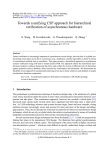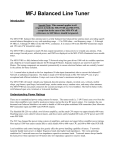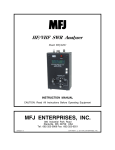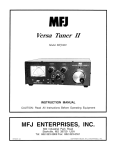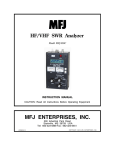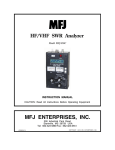Download MFJ 945D Instruction manual
Transcript
HF 10-160M SWR Analyzer Model MFJ-207 INSTRUCTION MANUAL CAUTION: Read All Instructions Before Operating Equipment MFJ ENTERPRISES, INC. 300 Industrial Park Road Starkville, MS 39759 USA Tel: 662-323-5869 Fax: 662-323-6551 VERSION 0B COPYRIGHT C 2006 MFJ ENTERPRIS ES , INC. MFJ-207 Instruction Manual HF 10-160M SWR Analyzer MFJ-207 Instruction Manual HF 10-160M SWR Analyzer DISCLAIMER Information in this manual is designed for user purposes only and is not intended to supersede information contained in customer regulations, technical manuals/documents, positional handbooks, or other official publications. The copy of this manual provided to the customer will not be updated to reflect current data. Customers using this manual should report errors or omissions, recommendations for improvements, or other comments to MFJ Enterprises, 300 Industrial Park Road, Starkville, MS 39759. Phone: (662) 323-5869; FAX: (662) 323-6551. Business hours: M-F 8-4:30 CST. MFJ-207 Instruction Manual HF 10-160M SWR Analyzer TABLE OF CONTENTS TOPIC PAGE 1. TABLE OF CONTENTS 2 2. LIST OF FIGURES AND TABLES 2 3. INTRODUCTION AND FEATURES 3 4. USES FOR THE MFJ-207 4 5. SYSTEM CONTROLS AND INDICATORS 5 6. THEORY OF OPERATION 7 7. MFJ-207 EASY-START INSTRUCTIONS 8. 8 IN CASE OF DIFFICULTY 17 9. TECHNICAL ASSISTANCE 17 APPENDICES A. ZERO BEATING AGAINST A RECEIVER 14 B. FREQUENCY/SWR PLOTTING CHART 15 C. SWR AT TRANSMITTER VS. SWR AT ANTENNA 16 LIST OF FIGURES Figure 1 Front Panel Jacks and Controls 5 Figure 2 End Panel Jacks 6 Figure 3 Block Diagram 7 Figure 4 MFJ-207 to Tuner Hook Up 10 Figure 5 Schematic Diagram 13 MFJ-207 Instruction Manual INTRODUCTION: HF 10-160M SWR Analyzer The MFJ-207 gives you a direct readout of your antenna’s SWR without the need for formulas or indirect readings. The MFJ-207 can also be used to adjust a tuner to match your antenna without the need for transmitting. The frequency coverage for the MFJ-207 is from below 1.75 MHZ to Above 30 MHZ in 5 user selectable bands. FEATURES Portable – The MFJ-207’s light weight, small size and internal battery capability makes it great for Field Day, Travel or any time you need to check out a new antenna installation quickly easily. Accurate – The Bridge Circuit uses precision resistors for utmost in accuracy. Great Value – The MFJ-207’s low cost puts a great instrument in your hands for those who only need to adjust their antennas occasionally. Stable – With built in AGC the MFJ-207 is accurate across the bands. No false readings. Rugged Construction: Attractive all-metal cabinet, conservative component selection and extensive RF filtering ensure solid performance for years to come. Fully covered by MFJ’s “No Matter What” one year limited warranty. Before attempting to operate your MFJ-207, please read the manual thoroughly. It contains important detail about setting up your unit to obtain the best performance. USES FOR THE MFJ-207 HF 10-160M SWR ANALYZER Your MFJ-207 SWR ANALYZER has many uses. It can be used to find the resonant frequency of your antenna, to find the SWR of your antenna at a particular frequency, and to find the frequency at which your antenna has the lowest SWR. You can also use the SWR Analyzer to adjust your antenna to a low SWR and to adjust an antenna tuner to match the transmitter to your transmission line. You can even find out if your antenna is resonant on more that one frequency. Measurement of the antenna’s SWR is done right at the input to the transmission line. There is no need to climb the tower and measure the SWR at the antenna. Also handy for suspended dipoles. Using the chart in Appendix C and knowing the line loss for your transmission line and the SWR at the line input, you can determine the SWR at the antenna, regardless of line length. MFJ-207 Instruction Manual HF 10-160M SWR Analyzer SYSTEM CONTROLS AND INDICATORS Front Panel Jacks and Controls 1 2 3 4 FIGURE 1: Front Panel Jacks and Controls 1. Power On LED: Instantly know if the MFJ-207 is on or off with this bright LED. 2. Band Select Switch: This 6 position switch turns the power on and selects any one of five over lapping bands. 3. Tune Control: This variable capacitor instantly sweeps across the desired band to find that SWR fast and easy. 4. SWR Meter: Direct readout of your SWR from 1:1 to Infinity. Frequency Coverage of the Bands NOTE: The frequency coverage may vary slightly from this chart and the label on the cover of the unit and is for reference only. A frequency counter can be connected to the Freq. Out connector shown in Figure 2 to get a more accurate reading of the frequency. As an alternative to a frequency counter you can Zero Beat the output with an HF receiver. See Appendix A. BAND A: BAND B: BAND C: BAND D: BAND E: 1.40 2.40 3.90 7.00 14.00 - 2.50 4.50 7.20 14.00 31.00 Mhz Mhz Mhz Mhz Mhz MFJ-207 Instruction Manual HF 10-160M SWR Analyzer SYSTEM CONTROLS AND INDICATORS End Panel Jacks FIGURE 2: End Panel Jacks 1. ANTENNA: This SO-239 Antenna connector allows you to easily hook up your station’s antenna to the MFJ-207. 2. FREQ. OUT: For additional accuracy you can hook up a frequency counter to this phono connector or feed the signal over a short piece of wire to your radio and zero beat against your radio as described in Appendix A. 3. PWR: This 2.1 mm jack allows you to attach a MFJ-1312D AC adapter or feed power from your station supply. MFJ-207 Instruction Manual HF 10-160M SWR Analyzer THOERY OF OPERATION Block Diagram FIGURE 3: Block Diagram Refer to Figure 3 and the Schematic diagram Figure 5 for this discussion of the theory of operation. RF is developed in the VCO consisting of L1 through L10 and the associated FETs Q1 and Q2 along with the variable capacitor. The Band Switch progressively shorts out the inductors as the frequency range is increased. The RF is then passed to Q3 and amplified. This RF is sensed by D2 and the resulting voltage is fed to U2 where it is amplified and fed to Q4. Q4 varies the voltage on the source of Q1 and Q2 maintaining the stable RF level. The Rf then goes to the bridge consisting of three fixed legs consisting of 49.9 Ohm resistors R7, R9 and R21. The 4th leg of the bridge is the unknown leg which is the Antenna input to the unit. When the bridge is unbalanced then D1 rectifies the unbalanced voltage and this is amplified by U2 and deflects the meter. MFJ-207 Instruction Manual HF 10-160M SWR Analyzer EASY START INSTRUCTIONS The MFJ-207 requires the optional MFJ-1312D power supply adapter or a nine-volt transistor battery. If using a battery with the MFJ-207 ensure it is an ALKALINE nine-volt battery. Additionally you can use a 13.8 volt power supply by connecting a 2.1 mm plug to the cable with the positive wire connected to the center pin and the ground wire connecter to the outer pin. To install the battery, remove the screws holding the cover onto the case. Insert the battery into the battery holder. Tuck the battery snap wires out of the way so they do not interfere with the tuning capacitor rotation. Reinstall the cover and screws. I. HOW TO MEASURE THE ANTENNA’S SWR AT A PARTICULAR FREQUENCY. 1. To check the SWR of your antenna, connect the antenna with a PL-259 connector to the ANTENNA connector on the MFJ-207. 2. If you are using open-wire feedline wire then first you must wire your feedline to a PL-259 connector and then attach it to the ANTENNA connector of the MFJ-207. 3. Set the BAND switch to the appropriate band. 4. Adjust the FREQUENCY DIAL of the SWR ANALYZER to the frequency at which you want to check the SWR. For added accuracy connect a frequency counter to the Freq. Out jack or zero beat against your receiver as described in Appendix A. 5. Read the SWR from the meter. This is the SWR at the INPUT TO THE TRANSMISSION LINE looking towards the load (antenna). To determine the SWR at the antenna refer to Figure **. 6. If the SWR at the SWR Analyzer is 1:1 then the SWR at the antenna is 1:1 at the selected frequency. 7. Using steps 1 through 5, you can make a plot of the SWR verses FREQUENCY for your antenna. Just plot the SWR at many different frequencies. Appendix B shows a SWR vs. FREQUENCY plotting chart. We suggest you make several copies of the chart so you can use it for several antennas. NOTE: It is advisable to take reading on several different bands to determine the frequency at which the lowest SWR occurs. The SWR can be low at several different frequencies, but there should only be one frequency that shows the LOWEST SWR. That frequency will be the natural resonant frequency of that antenna. MFJ-207 Instruction Manual HF 10-160M SWR Analyzer EASY START INSTRUCTIONS II. HOW TO MEASURE THE FREQUENCY AT WHICH THE ANTENNA HAS THE LOWEST SWR. 1. Connect the antenna as discussed in step I, 1 or 2. 2. Turn the BAND switch to the appropriate band. 3. Adjust the TUNE control throughout its range until the SWR meter reads its lowest value. Record the frequency on the frequency meter. Record the SWR on the meter. For added frequency accuracy hook up a frequency counter or refer to Appendix A. 4. If you do not obtain a low SWR on any frequency, turn the Band switch to another band and repeat steps 1-3 above. Don’t be surprised if your antenna does not show a 1:1 SWR on any frequency. Many antennas can be tuned to obtain a 1:1 SWR, but will never show a 1:1 SWR without an antenna tuner. III. Adjust the Antenna for 1:1 SWR. 1. Again connect the antenna as discussed in step I, 1 or 2. 2. Turn the BAND switch to the appropriate band. 3. Turn the Frequency TUNE knob until the pointer is on the frequency at which you want to tune the antenna. NOTE: For accuracy, use a frequency counter attached to the FREQ. Output on the SWR analyzer or zero-beat against your receiver. See Appendix A. 4. Read the SWR on the meter. If the meter reads other than 1:1 SWR then adjust your antenna until the antenna read 1:1 SWR or the lowest value obtainable. NOTE: The MFJ-207 can tell you whether the antenna element are to short or too long. If you find the resonant frequency of the antenna is lower than the frequency you wish then the elements are too long. If the resonant frequency is higher than you want then the elements are too short. HINT: If you are adjusting an antenna for the first time, it is recommended that you start with elements a little too long, then shorten to resonance. Again the SWR for your particular antenna may never get as low as 1:1. Always adjust for the lowest reading. MFJ-207 Instruction Manual HF 10-160M SWR Analyzer EASY START INSTRUCTIONS IV. Using the MFJ-207 to adjust an antenna tuner. 1. Connect you antenna to your antenna tuner. 2. Connect the MFJ-207 to the antenna tuner’s TRANSMITTER connector using a 2-3 foot length of RG-58 or RG-8. For ease of use see figure 4. 3. Turn the band switch to the appropriate band. 4. Set the frequency dial to the desired operating frequency. Adjust the tuner’s controls until the MFJ-207 indicates 1:1 SWR (nulls). 5. Disconnect the MFJ-207 completely and connect the transmitter to the tuner. 6. Always turn the Band switch to OFF when finished. CAUTION Never transmit into or through the MFJ-207. Take the MFJ-207 completely out of line before transmitting! Damage to your MFJ-207 will result if left in line. We recommend using the MFJ-1702 coax switch as shown in the diagram below for ease of use when changing bands. FIGURE 4: Hook-up for using the MFJ-207 to Tune Antenna Tuner MFJ-207 Instruction Manual HF 10-160M SWR Analyzer EASY START INSTRUCTIONS WARNING NEVER TRANSMIT WHILE THE MFJ-1702 COAX SWITCH IS SWITCHED TO A IF THE TRANSMITTER IS CONNECTED TO B. SERIOUS DAMAGE TO YOUR RADIO CAN OCCUR. TRANSMIT ONLY WHEN THE COAX SWITCH IS SWITCHED TO THE CONNECTOR TO WHICH THE TRANSMITTER IS CONNECTED. IF THE TRANSMITTER INPUT IS ON B, THEN TRANSMIT ONLY WHEN THE COAX SWITCH IS IN POSITION B. IF THE TRANSMITTER INPUT IS ON A, THEN TRANSMIT ONLY WHEN THE COAX SWITCH IS IN POSITION A. THE CENTER CONDUCTOR OF THE UNSELECTED COAX POSITION IS GROUNDED, SO TRANSMITTING INTO B WHILE THE SWITCH IS IN POSITION WILL CAUSE YOU TO TRANSMIT INTO A DEAD SHORT TO GROUND MFJ ENTERPRISES, INC, WILL NOT BE LIABLE FOR ANY DAMAGE TO YOUR RADIO OR OTHER EQUIPMENT DUE TO IMPROPER CONNECTION OR USE OF THE MFJ-1702 COAX SWITCH MFJ-207 Instruction Manual HF 10-160M SWR Analyzer EASY START INSTRUCTIONS FACTS ABOUT TRANSMISSION LINES AND LINE LOSS The MFJ-207 should be connected to the input to the transmission line looking toward the load. You do NOT have to know the length in wavelength of your transmission line, but you do need to know the length in feet (or meters) and the loss (in db) for the length of line that you are using at the frequency you are testing. Using the SWR/Line loss chart in Appendix C you can readily determine the SWR at the antenna. The most important consideration for any antenna system is probably the loss in the transmission line. The less loss, the better. Two important points about transmission lines need to be understood: 1. On a LOSSLESS transmission line, the SWR read at the transmitter is the same as the SWR at the antenna. For any line with loss the SWR is greatest at the antenna and minimum at the transmitter. 2. Regardless of the losses in the transmission line, if the SWR at the transmitter is 1:1, then the SWR at the antenna is 1:1, but if there is any SWR at the input to the transmission line there is a higher SWR at the antenna (assuming anything but a lossless line). Let’s go through a practical example. Let’s say you are using RG-58/U which has a loss of 2.3 db at 30 MHz per 100 feet. You are only using 50 feet of cable, so your loss when matched at the transmitter is 1.15 db at 30 MHz. Go to Appendix C and find the 1 db loss line which curves up and to the right. Now assume you are using your MFJ-207 and find the lowest SWR you can get on your antenna is 2.0:1. Follow the 1.15 db line (between the 1 db line and the 2 db line) down to th point it reads 2.0:1 on the horizontal axis (SWR at transmitter). Look at the vertical axis we can see that the point corresponds to an SWR of about 2.5:1 on the vertical axis. Reading this chart correctly tells us that with 50 feet of RG-58/U that has a loss of 2.3 db per 100 feet at 30 MHz and a line input SWR of 2.0:1, the SWR at the antenna is 2.5:1. By the way, the 2.0:1 SWR at the load only adds about .225 db of loss to the already matched 1.4 db of loss foe a total loss of 1.625 db. (See ARRL Antenna book) MFJ-207 Instruction Manual HF 10-160M SWR Analyzer Figure 5: MFJ-207 Schematic Diagram MFJ-207 Instruction Manual HF 10-160M SWR Analyzer APPENDIX A HOW TO ZERO BEAT THE MFJ-207 AGAINST THE RECEIVER The Freq. Out jack on the MFJ-207 has a sine wave output which can be used to accurately check the frequency at which the MFJ-207 is adjusted to. To zero-beat against the receiver, loosely couple a wire from the RCA jack (Freq. Out) to the antenna connector on your radio. First, try a small length of wire from the Freq. Out connector of the MFJ-207. Just leave it dangling free, not touching the Antenna input of the receiver. Place the far end of the wire near the receiver but do not connect it to the receiver’s input unless you simply cannot hear the signal at all. The output of the MFJ-207 is a high level and damage to the front end of some radios may occur with a direct connection, so you assume all risks in making a direct connection. Turn the radio on and tune to the frequency in question. For example, if you want to check your 40 meter dipole on 7.235 MHz, set the radio for 7.235 MHz. Turn the RF gain and the Audio of you radio down as the level of the MFJ-207 is strong. Put your radio in the CW mode. If you have a BFO adjustment on your radio, be sure to set the BFO to ON and to 0 (zero). Set the MFJ-207 to band C. Adjust the tune dial on the MFJ-207 until you start hearing a tone in the radio’s speaker. As you slowly turn the TUNE dial, the frequency will start at a very high pitch, and then decrease to zero pitch. The point where the tone goes to zero hertz is the “zero-beat”. That means the MFJ-207 is set exactly to the setting on the radio. Now make a note of where the dial is set on the MFJ-207 so you can re-set the frequency if you accidentally bump the TUNE control. You can now disconnect the wire and re-connect the antenna to the MFJ-207. MFJ-207 Instruction Manual HF 10-160M SWR Analyzer APPENDIX B FREQUENCY/SWR PLOTTING CHART MFJ-207 Instruction Manual HF 10-160M SWR Analyzer APPENDIX C SWR at Transmitter Vs. SWR at Antenna MFJ-207 Instruction Manual HF 10-160M SWR Analyzer TECHNICIAL ASSISTANCE IN CASE OF DIFFICULTY [ ] Unit will not turn on – Ensure you have a fresh battery in the unit or your power supply is plugged in all the way to the unit. [ ] Unit drifts excessively – This is normally caused by low battery voltage. Replace the battery with a fresh battery. [ ] Meter never moves off full scale – Ensure your antenna is properly connected to the unit. TECHNICAL ASSISTANCE If you have any problem with this unit first check the appropriate section of this manual. If the manual does not reference your problem or is your problem is not solved by reading the manual, you may call MFJ Technical Service at 662-323-0549 or the MFJ Factory at 662-323-5869. You will be best helped if you have your unit, manual and all information on your station handy so you can answer any questions the technician may ask. You can also send questions by mail to MFJ Enterprises, Inc., 300 Industrial Park Road, Starkville, MS 39759; by Facsimile (FAX) to 662-323-6551; or by email to [email protected]. Send a complete description of your problem, an explanation of exactly how you are using your unit , and a complete description of your station. MFJ-207 Instruction Manual HF 10-160M SWR Analyzer MFJ-207 Instruction Manual HF 10-160M SWR Analyzer FULL 12-MONTH WARRANTY MFJ Enterprises, Inc. warrants to the original owner of this product, if manufactured by MFJ Enterprises, Inc. and purchased from an authorized dealer or directly from MFJ Enterprises, Inc. to be free from defects in material and workmanship for a period of 12 months from date of purchase provided the following terms of this warranty are satisfied. 1. The purchaser must retain the dated proof-of-purchase (bill of sale, canceled check, credit card or money order receipt, etc.) describing the product to establish the validity of the warranty claim and submit the original or machine reproduction of such proof of purchase to MFJ Enterprises, Inc. at the time of warranty service. MFJ Enterprises, Inc. shall have the discretion to deny warranty without dated proof-of-purchase. Any evidence of alteration, erasure, of forgery shall be cause to void any and all warranty terms immediately. 2. MFJ Enterprises, Inc. agrees to repair or replace at MFJ's option without charge to the original owner any defective product provided the product is returned postage prepaid to MFJ Enterprises, Inc. with a personal check, cashiers check, or money order for $10.00 covering postage and handling. 3. MFJ Enterprises, Inc. will supply replacement parts free of charge for any MFJ product under warranty upon request. A dated proof of purchase and a $8.00 personal check, cashiers check, or money order must be provided to cover postage and handling. 4. This warranty is NOT void for owners who attempt to repair defective units. Technical consultation is available by calling (662) 323-5869. 5. This warranty does not apply to kits sold by or manufactured by MFJ Enterprises, Inc. 6. Wired and tested PC board products are covered by this warranty provided only the wired and tested PC board product is returned. Wired and tested PC boards installed in the owner's cabinet or connected to switches, jacks, or cables, etc. sent to MFJ Enterprises, Inc. will be returned at the owner's expense un-repaired. 7. Under no circumstances is MFJ Enterprises, Inc. liable for consequential damages to person or property by the use of any MFJ products. 8. Out-of-Warranty Service: MFJ Enterprises, Inc. will repair any out-of-warranty product provided the unit is shipped prepaid. All repaired units will be shipped COD to the owner. Repair charges will be added to the COD fee unless other arrangements are made. 9. This warranty is given in lieu of any other warranty expressed or implied. 10. MFJ Enterprises, Inc. reserves the right to make changes or improvements in design or manufacture without incurring any obligation to install such changes upon any of the products previously manufactured. 11. All MFJ products to be serviced in-warranty or out-of-warranty should be addressed to MFJ Enterprises, Inc., 300 Industrial Park Rd, Starkville, Mississippi 39759, USA and must be accompanied by a letter describing the problem in detail along with a copy of your dated proof-of-purchase and a telephone number. 12. state. This warranty gives you specific rights, and you may also have other rights, which vary from state to




















